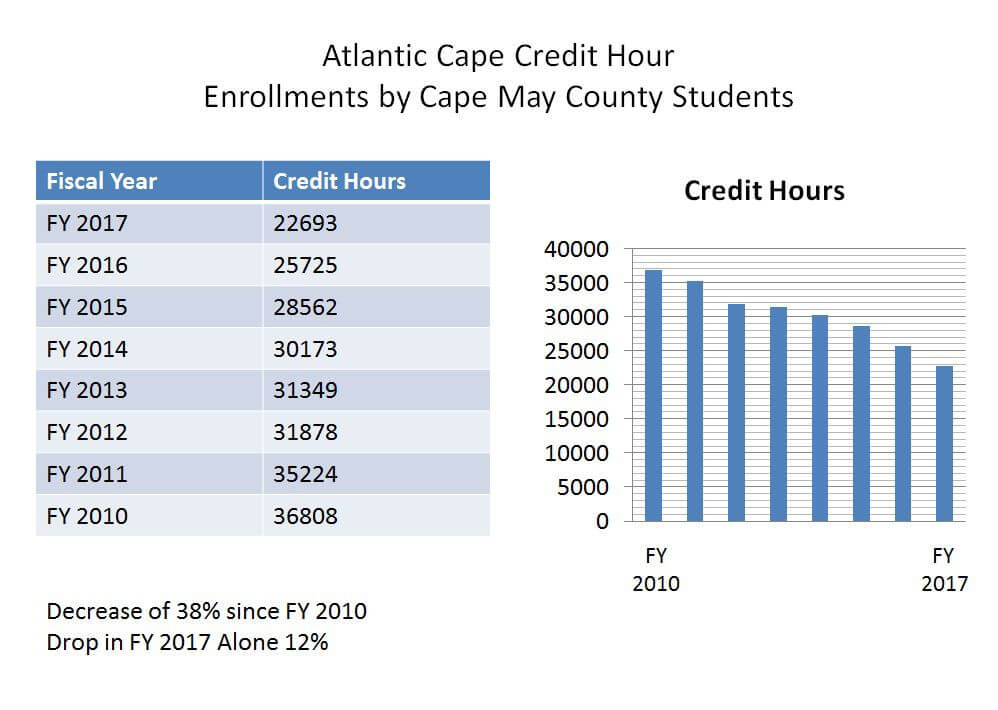COURT HOUSE – The loss of enrollments at Atlantic Cape Community College’s Cape May Campus is accelerating, down 12 percent in fiscal year 2017.
The total credit hours taken by Cape May County students are at a lower point than they were before the Court House campus opened in 2005.
In terms of face-to-face instruction, the county is 4,000 credit hours below the total achieved the year before the campus opened.
The 2016 Series
As Atlantic Cape Community College’s campus in Cape May County celebrated its 10th anniversary, The Herald published a series of articles in 2016 looking at the hopes and dreams that were associated with the ribbon cutting in 2005 and the reality that emerged in that first decade.
The picture was one of initial growth followed by a continuous decline in program offerings, enrollments, and the role of the new campus in the county.
The series concluded that many of the hopes for the campus had fallen short of being realized and the focus for the future needed to be the “community needs and dreams for the next decade.”
Declining enrollments continued. In April 2017, The Herald reported on a number of layoffs at Atlantic Cape forced by continued drops in unrestricted revenue from tuition, fees and federal financial aid. It reported that those declines in revenue were “showing no signs of bottoming.”
In 2017, Atlantic Cape changed leaders. Dr. Peter Mora retired as president after 41 years at the institution, 12 as president.
Dr. Barbara Gaba became the institution’s ninth president in January.
This change midway through the fiscal year meant that Mora introduced the 2017 budget and Gaba issued the year’s financial results.
The 2017 Results
In his budget message for 2018, Mora predicted a continued decline in enrollments, projecting another 5 percent loss in credit hours taken. The results contained in the year’s financial statements showed a decline at better than 10 percent for the college as a whole and 12 percent in Cape May County enrollments.
The decline in enrollment is not only continuing; it is accelerating.
The identified causes continue to be the same: loss of overall population in the serving area, the closing of four casinos in Atlantic City, and demographic changes in the two counties that have led to a decline of 18-24-year-olds, identified by Gaba as “90 percent of our customer base.”
When comparing Cape May County’s peak enrollment at Atlantic Cape in the year 2010 with these latest numbers, the loss is greater than 40 percent, wiping out all of the gains achieved after the local campus opened in 2005.
President Gaba is acutely aware of the dilemma facing the institution. In Cape May County, she has taken steps to appoint a full-time dean for the campus, one who lives in the county, Marie Kellet, a 10-year veteran of the institution.
Gaba understands the need for community involvement in making the branch campuses in Cape May County and Atlantic City viable community resources. Regardless, the flexibility to act is restricted every day that revenue continues to decline.
Demographic realities suggest that a turnaround strategy for Atlantic Cape cannot continue to depend on a core 18-24-year-old population interested in traditional college degrees.
That population is decreasing, and deeper penetration into the high school graduate pool is producing more students in need of remedial work for traditional college programs.
To the degree that the college is going to continue its reliance on younger students, the need to move beyond traditional academic instruction and into more workforce readiness programs appears to be part of the solution.
Online programs have been among the only things preventing Cape May County enrollments from even steeper declines. Yet even those are decreasing, dropping 11 percent in two years.
The strategies of the last several years have not worked in reviving enrollments. New strategies are needed.
Make Community College Free?
Although the losses at Atlantic Cape have been steeper than those at the state’s community colleges as a whole, declining enrollment has been a constant theme across New Jersey’s two-year public institutions. It is not surprising that the state’s 19 community colleges have lined up to support newly-sworn Gov. Phil Murphy’s call for free two-year college education in the state.
Murphy, an avowed progressive, has touted this concept for years. It was not just a campaign position.
Exactly how it would work is not entirely clear. Here is what it looks like:
The program would be a “Last-Dollar Scholarship” program. That means that students would still apply for federal financial aid, taking advantage of grant possibilities, especially Pell Grants. Normal state and county aid that is separate from tuition and fees would also remain.
An assumption is that students would not have to apply for federal loans to cover the shortfall in tuition and fees after grants are applied because of the state scholarship.
Since students would still be responsible for non-tuition and fee charges for items like books, special equipment and the like, federal loans at a much smaller level might still play a role.
A few states have similar programs, and each is different from the others in details. The one most often cited as a potential model for New Jersey is the program in Tennessee.
There, however, the benefits are largely limited to recent high school graduates. Benefits for those over 24 returning to school are limited.
What restrictions might apply to a New Jersey program are unclear. Would the program apply to adults returning to college when they are over 24-years-old? Would the benefits of the program apply to high school graduates who must spend a year or more in remedial classes?
Would the program apply to courses that link community college work to vocational certifications that might not result in an Associate’s degree? The details are not yet available.
Money
One of the greatest obstacles in the way of this ambitious plan to increase enrollments at two-year institutions is, predictably, money.
Murphy has estimated the cost of the program at somewhere between $400 million (an early estimate) and $200 million (a later estimate).
Murphy has cited a few possible sources for the funds including new taxes on those above certain income and asset levels as well as tax revenue generated from the sale of legalized marijuana.
To tap either of those sources, bills would need to get through the Legislature and headwinds are possible.
The other reason money may be the chief obstacle is this program is not alone as an expensive new initiative in Murphy’s plans.
Infrastructure needs, K-12 funding, and affordable housing initiatives all share the priority list with free community colleges.
The order of those priorities will probably not be clear until at least the point when the governor submits his first budget to the Legislature.
Opponents of the plan point out that there is no “free lunch.” Making community colleges free to every high school graduate means the expense has been added to the general expense facing the taxpayer and makes it part of the debate over who pays what regarding tax policy.
Those who argue against the plan also note that it does not speak to the issue of success rates or lack of academic preparation. They express concern that this is money going into a system that has not proven it can be successful.
A significant rise in enrollments for free tuition and fees may mean a rise in the number of students who fail to succeed.
Part of a Larger Issue
How to reverse the enrollment decline at the Atlantic Cape campus in Court House needs to be part of a community-wide discussion on priorities for resources, goals that are tied to community needs, and ways to link educational systems in ways that benefit the county’s residents and economy.
Without intervention, there is no reason to expect that next year’s numbers will be any better than this year’s numbers.
To contact Vince Conti, email vconti@cmcherald.com.
Cape May County – All the spouting and you didn’t change the world a single bit. Weeek after week year after year. Not a single thing. Please moderator your authority is nonsense and don’t leave a note I don’t want to…








